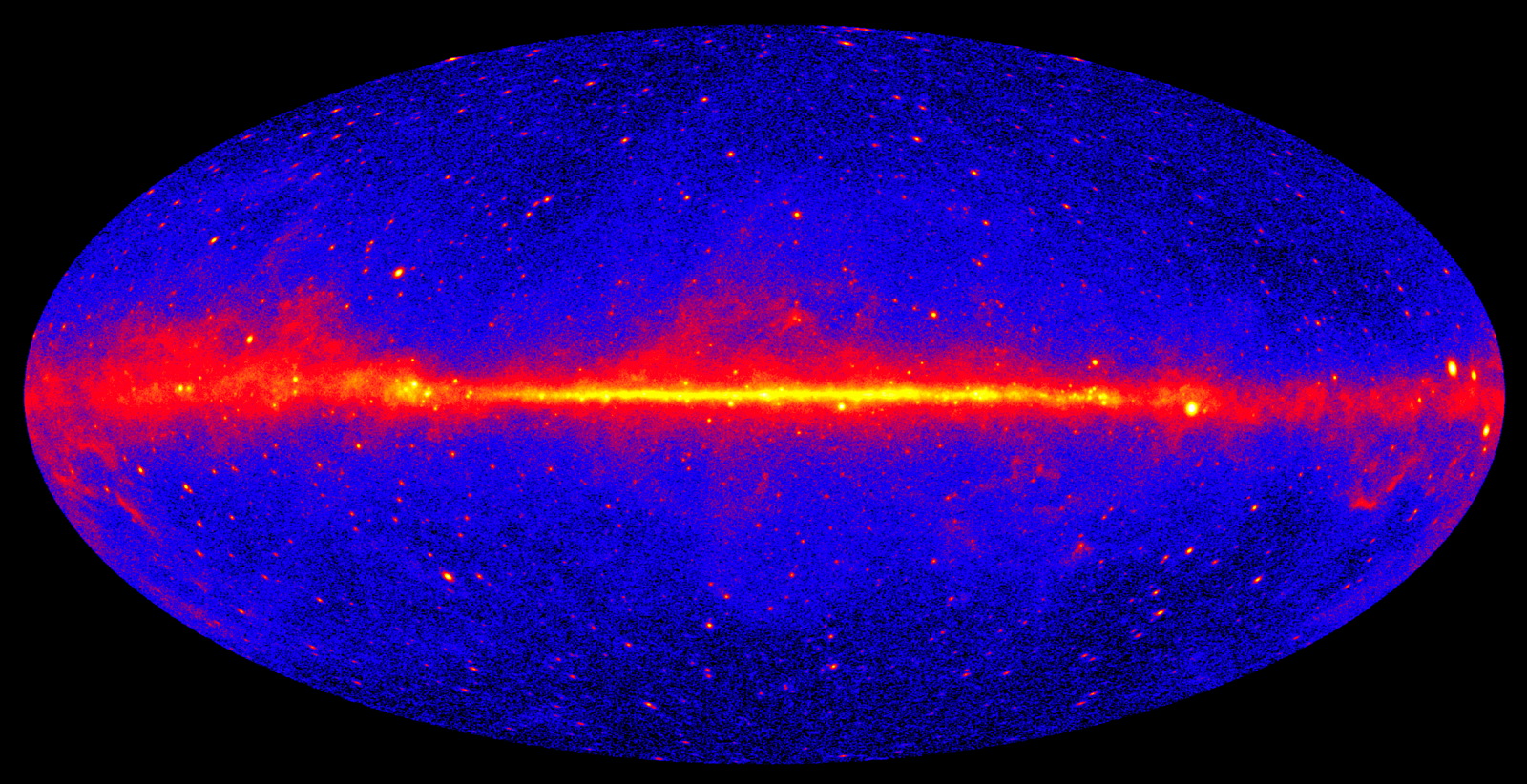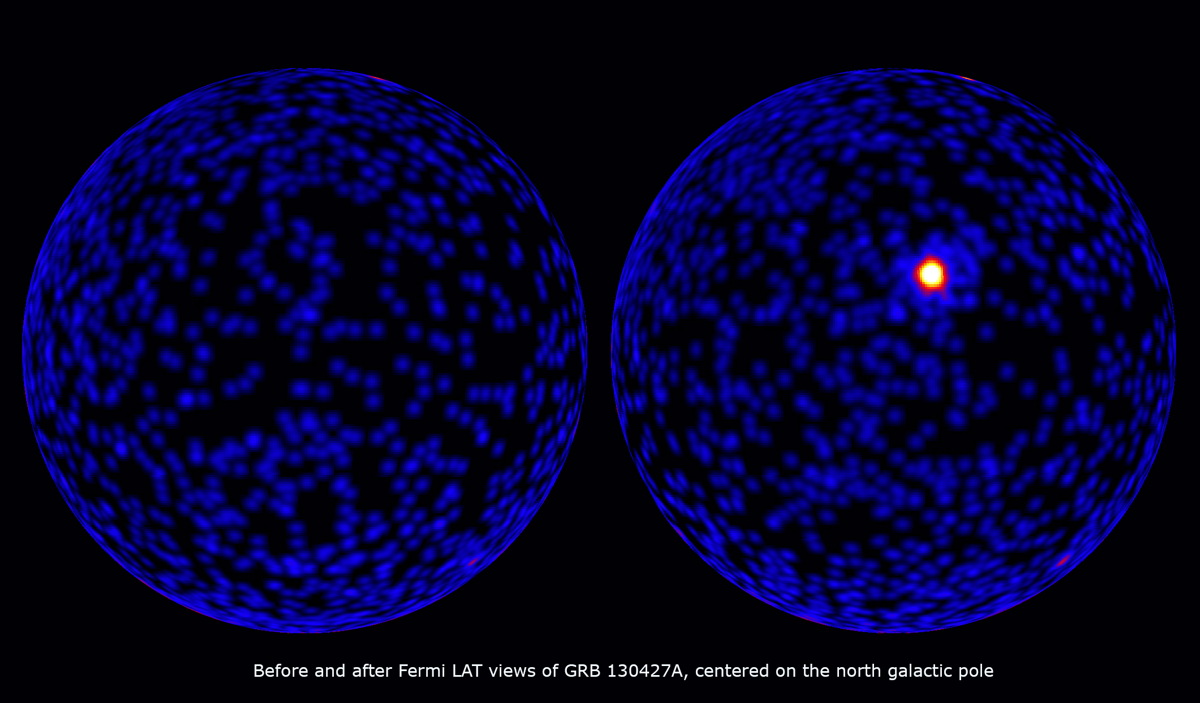Mystery of the Universe's Gamma-Ray Glow Solved

The steady glow of high-energy gamma-ray light that spreads across the cosmos has puzzled astronomers for decades. One team of researchers thinks it has the best explanation yet for the source of this strange emission.
After observing the universe with NASA's Fermi Gamma-ray Space Telescope for six years, scientists with the mission say the majority of the gamma-ray glow they have seen can be explained by objects already known to science. If there are any as-yet unknown sources out there, their contribution to the glow would be very small, scientists say.
"We have a very plausible story. We're not 100 percent confident that this is the final answer, but it really constrains what other exotic possibilities could be out there," said Keith Bechtol, a postdoctoral researcher at the University of Chicago and a member of the Fermi collaboration who worked on the analysis. [Fermi's Gamma-Ray Universe in Images (Gallery)]
Fermi: a gamma-ray gumshoe
NASA's Fermi Gamma-ray Space Telescope snaps pictures of the entire observable universe — from end to end — in gamma-rays, which are some of the highest-energy photons in nature.
While that wide view of the universe is useful, it can make it a challenge to pinpoint the exact sources of these gamma-rays. Instead, Fermi sees a diffuse glow coming from the universe. This glow is technically known as the extragalactic gamma ray background, or the EGB. Previous gamma-ray telescopes have also seen this light that fills the background of the cosmos.
"We've known about this gamma-ray background since the late 1960s," Bechtol said. "It's a very-long-standing mystery, and each generation of gamma-ray telescopes has given us a little more information."
With help from other telescopes, the Fermi telescope can identify where some of this high-energy background light is coming from. There are very energetic galaxies called blazars, for example, that give off a high flux of gamma-rays. The Energetic Gamma Ray Experiment Telescope (EGRET), which preceded Fermi, broke records by detecting some 300 gamma-ray sources. So far, the Fermi telescope has identified more than 3,000 sources.
Get the Space.com Newsletter
Breaking space news, the latest updates on rocket launches, skywatching events and more!
But 3,000 is only a drop in the ocean of gamma-ray sources in the entire universe, scientists say. [Top 10 Gamma-Ray Sources in the Universe]
"We think every galaxy is producing gamma-rays at some level," Bechtol said. "The vast majority are too faint to be seen individually and instead their collective emission is blurred together." (Many galaxies radiate high levels of optical light, and can be seen by telescopes like the Hubble. But their gamma-ray emission is too faint to be detected.)
"It's frustrating not to know the answer, but the fact that there's a mystery — I think that's what attracted a lot of us to this problem," Bechtol said. "At least for me, I like being on the edge of that discovery space where there's still blank parts on the map."
Cracking the mystery
The Fermi telescope can't see most of the objects that radiate gamma-ray light, so the scientists have to try to estimate how many gamma-ray objects are out there.
In an analysis first made public in September 2014, members of the Fermi collaboration took the known sources of gamma-rays and added them together with models that predicted the frequency and location of unseen sources. The scientists calculated how much gamma-ray light both the detected and modeled sources would produce together.
This calculated output of gamma rays matches closely with the actual gamma ray-background that Fermi observes — the entire EGB.
The final estimate shows that roughly 50 percent of the gamma-ray background comes from extremely energetic galaxies known as blazars. Ten to 30 percent of the gamma ray background emanates from star-forming galaxies like the Milky Way, which can collectively contain many smaller gamma-ray sources, like supernovas. Another 20 percent is from radio galaxies, which are blazars, but are pointed away from the Earth, and thus cannot be seen as easily by Fermi.
"There could definitely be new gamma-ray sources out there," Bechtol said. "It's just that their total contribution would have to be relatively small."
It's also possible that dark matter — the mysterious material that makes up 80 percent of all the matter in the universe — is producing gamma-rays, and the Fermi results may help scientists figure out what kind of particle (or particles) make up dark matter.
Two large uncertainties remain in Fermi's estimation. First, it is difficult to measure the gamma-ray glow of the universe to begin with, and Bechtol said he and his collaborators put a lot of time into improving that measurement.
Second, the scientists are making estimates about objects they cannot directly observe, most of which are located beyond the Milky Way galaxy (or extragalactic).
"When [scientists] first discovered the gamma-ray background, it was largely a mystery as to what created it," Bechtol said. "And now it seems like everything is fitting together very well. Right now, the simplest explanation involving known astrophysical sources seems to be doing just fine."

Light from back in time
Fermi's success at decoding the gamma-ray background had depended largely on its increased sensitivity to gamma-rays and its detection of more gamma-ray sources than previous telescopes. In addition, Fermi scientists have worked to gain a better understanding of how gamma-ray emissions have changed throughout the history of the universe. This is valuable because when Fermi looks at sources of gamma-rays, it is actually looking into the past.
Light travels at a finite speed — the light from the sun takes 8 minutes to reach Earth, which means humans actually see the sun as it was 8 minutes ago. By the same logic, objects that are billions of light-years away from Earth are seen by Fermi as they were billions of years ago.
"We're literally measuring the light output over the history of the universe, and for me, that's what makes this exciting," Bechtol said. "We're seeing all different time periods in the universe at the same time. All of the light from all those different periods is added together to form the gamma ray background."
Having a historical perspective makes a big difference for Fermi because the cosmic output of gamma-rays has likely been different at various times throughout the last 13 billion years. For example, the universe has seen periods when the population of blazars exploded and other times when the population growth slowed down. They also need to understand precisely how far away those blazars are, in order to accurately measure how long ago these bright sources burned.
The Fermi scientists have solved a long-standing puzzle, but Bechtol said there are still other mysteries in the gamma-ray universe. There are other gamma-ray telescopes that can detect even higher-energy gamma-rays than Fermi, and it's possible that in those energy ranges, there are sources of gamma-rays that scientists don't know about yet.
"We think this [result] is converging on the final answer, but history has shown us that, sometimes, there's more to the story," Bechtol said. "I certainly think that, as we start to look at higher energies […], there will start to be some surprises."
Follow Calla Cofield @callacofield. Follow us @Spacedotcom, Facebook and Google+. Original article on Space.com.
Join our Space Forums to keep talking space on the latest missions, night sky and more! And if you have a news tip, correction or comment, let us know at: community@space.com.

Calla Cofield joined Space.com's crew in October 2014. She enjoys writing about black holes, exploding stars, ripples in space-time, science in comic books, and all the mysteries of the cosmos. Prior to joining Space.com Calla worked as a freelance writer, with her work appearing in APS News, Symmetry magazine, Scientific American, Nature News, Physics World, and others. From 2010 to 2014 she was a producer for The Physics Central Podcast. Previously, Calla worked at the American Museum of Natural History in New York City (hands down the best office building ever) and SLAC National Accelerator Laboratory in California. Calla studied physics at the University of Massachusetts, Amherst and is originally from Sandy, Utah. In 2018, Calla left Space.com to join NASA's Jet Propulsion Laboratory media team where she oversees astronomy, physics, exoplanets and the Cold Atom Lab mission. She has been underground at three of the largest particle accelerators in the world and would really like to know what the heck dark matter is. Contact Calla via: E-Mail – Twitter









